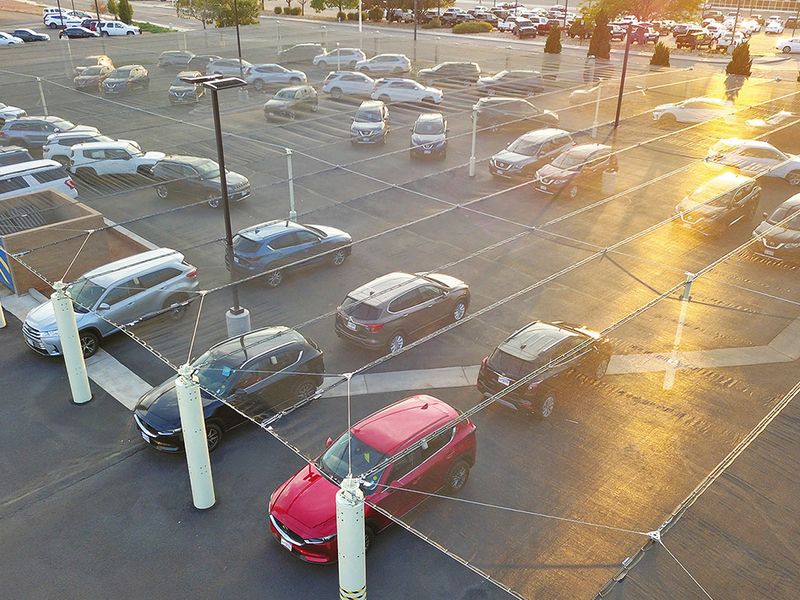
Of the 12 costliest hailstorms in Colorado history, nine have taken place since 2008. Caught directly in the crosshairs of No. 8 on the list — a June 2018 storm that resulted in $276.4 million in damages — was Denver-based Schomp Automotive Group.
“That month we purchased three new dealerships on the east side of Denver, and within a 10-day period they were hit with hail three times,” says Michael Dunlap, vice president of business development at Schomp, which operates nine dealerships in the Denver area. “We had cars that were damaged, repaired, put back onto the front line and then damaged again.”
The group’s 2018 hail losses totaled nearly $200,000, prompting Schomp to start looking at protective solutions.
That same year, insurers began backing away from offering Dealer Open Lot coverage because of the increasing severity of hail damage. Zurich NA also decided not to renew hundreds of policies in hail-prone areas in 2018 citing “catastrophic losses,” though it does continue to provide coverage in many states.
Other insurers have continued to drop the coverage, says Kevin Gast, Dealer Open Lot program manager at Ryan Specialty Group, an insurance broker. According to Gast, up to 70 percent of carriers have exited the space.
“Hail’s getting bigger and cars are being made with more lightweight parts, so the cost per car to fix has gone up,” Gast says. “Even on the East Coast and outside the hail belt, there’s more damage. But in hail alley, deductibles have gone from $500 a car to $3,500 with no aggregate, so dealers in places like Colorado are really getting hit hard.”
From 2015 to 2021, Schomp’s premiums for Dealer Open Lot coverage went from $28,000 a month to $141,000 — a nearly 400 percent increase, Dunlap says.
In response, the group developed “Hail No,” a system that uses translucent high-strength netting mounted between metal posts driven into the ground to shield vehicles from the damage.
Unlike hard canopy solutions or large tents, the system allows inventory to be seen by customers and staff and it can be easily taken down and stored during winter months, Dunlap says. If the netting does get snowed on, it’s designed to flex under the weight of one foot of snow.
“We tested the system at our dealer campus in Highlands Ranch, and then refined it after seeing it in action,” Dunlap says.
The group plans to install the system at all of its locations.
“We’re getting about a 50 percent reduction on our insurance premium for the inventory that’s covered, which should pay for the system within a couple of years,” Dunlap says.
Schomp is in talks with other dealers about installing Hail No.
The system costs about $1,400 to $1,750 per vehicle stall — or about $8.25 to $10.30 per square foot.
“Most of the cost is in the steel support columns,” Dunlap says, noting the installation of the columns varies depending on complexity of a site.
Hail No isn’t the only netting-and-post solution on the market. British Columbia-based WeatherSolve, which specializes in weather barrier solutions, offers a similar product called Hail Canopy.WeatherSolve’s canopies are in use at one dealership in Colorado and six more in Alberta, Canada, according to Taylor Gallivan, a business development specialist with the company.
The cost of installation can vary depending on the site and ground soil, Gallivan says, but it’s generally in the range of $6 to $10 per square foot. A smaller version, for single- or double-row lot coverage, also is available.
Skyler Leavitt, general manager at CSL Ford Sales in Cardston, Alberta, installed the WeatherSolve canopy in 2019 after several years of increasing insurance premiums and scrambling to avoid hail damage.
“We would scramble to put vehicles in every nook and cranny of our buildings,” Leavitt says. “We’d even drive them to private garages sometimes.”
Leavitt says that the system hasn’t reduced his insurance premiums and he feels it’s unlikely to in the near term. Insurance companies will require more long-term data about the efficacy of such setups, he says. However, he’s still gotten lots of value out of the nets.
The system protected his inventory during a 2020 hail event that became the fourth-costliest natural disaster in Canadian history.
“We’ve gone from deductibles of $100 per car to $3,000” Canadian, Leavitt says.
The canopy, he says, both protects the inventory and eliminates most of the hassle of filing claims or finding replacement inventory.
Three-thousand-dollar deductibles “add up quick,” Leavitt says.
“If you have one, maybe two hailstorms that are bad enough for you to start claiming insurance on, your entire structure will be paid for.”